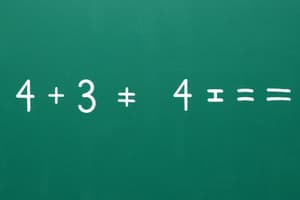Podcast
Questions and Answers
Which of these strategies is NOT a common addition and subtraction strategy?
Which of these strategies is NOT a common addition and subtraction strategy?
- Finding the square root (correct)
- Breaking down numbers
- Compensation
- Using number lines
The commutative property of addition states that the order in which numbers are added does not affect the sum.
The commutative property of addition states that the order in which numbers are added does not affect the sum.
True (A)
What is the sum of 37 and 45?
What is the sum of 37 and 45?
82
In two-digit subtraction, borrowing is needed when the ones digit of the ______ number is smaller than the ones digit of the ______ number.
In two-digit subtraction, borrowing is needed when the ones digit of the ______ number is smaller than the ones digit of the ______ number.
Match the following addition and subtraction strategies with their descriptions:
Match the following addition and subtraction strategies with their descriptions:
Which strategy uses the fact that adding numbers in any order results in the same sum?
Which strategy uses the fact that adding numbers in any order results in the same sum?
Estimating sums and differences can help in checking the accuracy of calculations.
Estimating sums and differences can help in checking the accuracy of calculations.
What does the 'counting back' strategy involve?
What does the 'counting back' strategy involve?
Regular ______ is crucial for gaining fluency in addition and subtraction, especially for numbers 1 to 100.
Regular ______ is crucial for gaining fluency in addition and subtraction, especially for numbers 1 to 100.
Match the problem-solving strategies with their respective descriptions:
Match the problem-solving strategies with their respective descriptions:
Flashcards
Using Doubles
Using Doubles
A strategy to quickly determine the sum of two identical numbers.
Counting Back
Counting Back
A method of subtraction where you start from the larger number and count down.
Estimating Sums
Estimating Sums
Using rounding to quickly find approximate sums or differences.
Word Problems
Word Problems
Signup and view all the flashcards
Practice for Fluency
Practice for Fluency
Signup and view all the flashcards
Commutativity
Commutativity
Signup and view all the flashcards
Inverse Operation
Inverse Operation
Signup and view all the flashcards
Doubles Strategy
Doubles Strategy
Signup and view all the flashcards
Place Value
Place Value
Signup and view all the flashcards
Borrowing in Subtraction
Borrowing in Subtraction
Signup and view all the flashcards
Study Notes
Addition Facts (1-100)
- Mastering addition facts from 1 to 100 is fundamental for more complex mathematical operations.
- Understanding basic addition principles, such as commutativity (order doesn't matter: 2 + 3 = 3 + 2), is crucial.
- Practice addition problems involving single-digit numbers.
- Progress to two-digit numbers and their combinations.
- Mental math strategies are valuable for quick calculations.
- Use number lines, visual aids, or other tools to visualize sums.
Subtraction Facts (1-100)
- Subtraction is the inverse operation of addition.
- Mastery of subtraction facts is essential for problem-solving.
- Understand the relationship between addition and subtraction.
- Practice with various subtraction problems, starting with single-digit numbers.
- Gradually increase the complexity by including double-digit numbers.
- Utilize strategies like counting back, using complements (finding the difference from 10, 20, etc.), or breaking down numbers.
Addition and Subtraction Strategies
- Breaking down numbers: Splitting numbers into smaller, manageable parts (e.g., 27 + 15 = (20 + 10) + (7 + 5)).
- Using number lines: Visual representation of addition (moving forward) and subtraction (moving backward).
- Compensation: Adjusting numbers to make calculations easier (e.g., 37 + 9 ≈ 37 +10 -1).
- Complements: Using known addition facts to find the remaining component (e.g., 10 - 7 = 3)
- Doubles and near doubles: Recognizing and using doubles (e.g., 5+5 = 10) to find near doubles (e.g., 6 + 5 = (5 + 5) + 1)
Two-Digit Addition
- Adding two two-digit numbers requires understanding place value (ones and tens).
- Start by adding ones, then tens, carrying over if necessary.
- Visual aids like base-10 blocks can be beneficial for visualizing place value.
- Examples:
- 25 + 34 (First: 5 + 4 = 9. Then 20 + 30 = 50)
- 58 + 24 (First: 8 + 4 = 12, write 2 and carry 1. Then 50 + 20 + 1 = 71)
Two-Digit Subtraction
- Subtracting two two-digit numbers involves understanding place value.
- Borrowing from the tens place is sometimes necessary when the ones digit of the top number is smaller than the ones digit of the bottom number.
- Examples:
- 76 - 43 (First 6-3 = 3, then 70-40=30)
- 81 - 29 (First, 1 cannot subtract 9. Borrow from 8 tens, making 7 tens and 11 ones. Then 11-9 = 2. Next 70-20= 50).
Mental Math Techniques
- Counting on: Start with the larger number and count up to the second number.
- Using doubles: Quickly determining sums of numbers that are doubles.
- Counting back: For subtraction, start with the larger number and count back to find the difference.
- Using number properties (commutativity, associativity, identity).
Estimation
- Estimating sums and differences helps with problem-solving and checking answers.
- Rounding to the nearest tens place can be a useful strategy for estimation.
- By rounding numbers, and making a suitable estimate, calculations can be faster and answers are very close to the exact result.
Word Problems
- Word problems involve applying addition and subtraction skills to real-world scenarios.
- Identify the key information and the operation needed.
- Formulate the answer and check your work.
Practice and Rehearsal
- To achieve fluency, regular practice is essential for both addition and subtraction problems involving numbers 1 to 100.
- Repetition and using different strategies will make a greater impact on mastering the calculations.
Studying That Suits You
Use AI to generate personalized quizzes and flashcards to suit your learning preferences.




